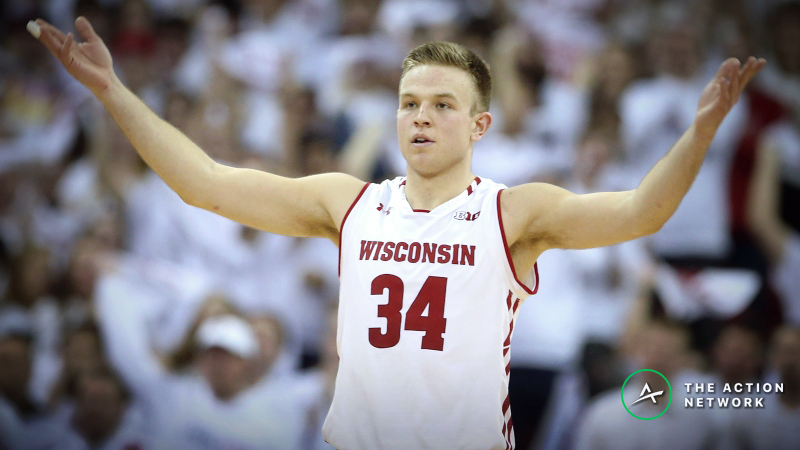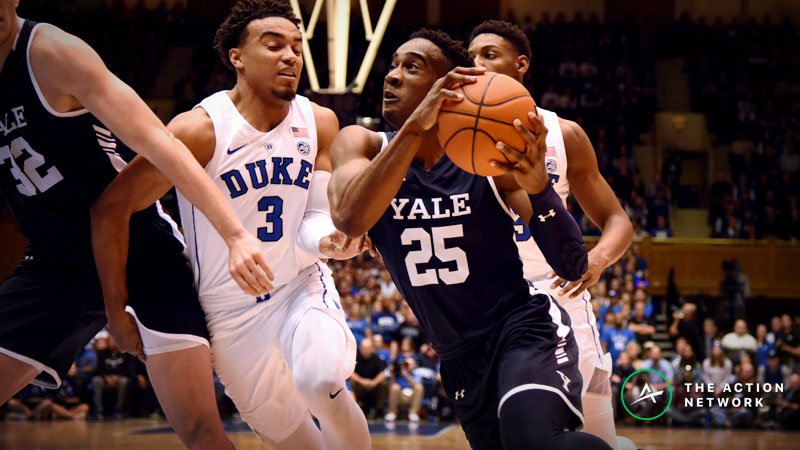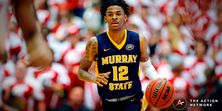Last March, Loyola-Chicago ripped through the NCAA Tournament's South Region as a No. 11 seed en route to the Final Four.
The Ramblers had 380-1 odds to win it all before it tipped off, proving that betting on futures — with the intention of hedging down the line — can be profitable well before the big dance gets underway. A moneyline rollover is always an option, as well.
Which dark horses can make a run in March Madness this season? Let's break down the value.

NCAA Tournament Sleepers, East Region
Statistics via KenPom.com
Liberty (1,000-1): This part of the bracket has No. 1 seed Duke and No. 2 Michigan State, so there's not much value for those teams' potential matchups in the Round of 32. But the No. 12 Flames (17-14 against the spread), winners of the Atlantic Sun Conference tournament, have some sleeper potential to reach the Sweet 16.
Ritchie McKay's bunch owns the 56th-highest Adjusted Offensive Efficiency (110.6 points per 100 possessions) in the nation, and it's geared to slow the opposition down via the fifth-slowest Adjusted Tempo (61.7 possessions per 40 minutes). Liberty also turns opponents over at the 54th-highest rate (20.8%) while limiting them to the 85th-lowest eFG% (48.7%), allowing it to control the pace.
That's a good recipe for an upset.
Yale (1,000-1): Even though the No. 14 seeded Bulldogs (16-12 ATS) are facing No. 3 LSU in the Round of 64, James Jones' success in the big dance is documented, knocking off Baylor as a No. 12 seed before giving Duke all it could handle in the 2016 NCAA Tournament.
Yale boasts the 44th-highest AdjO (111.7 points per 100 possessions) in Division I, led by 6-foot-6 Miye Oni (17.6 ppg). Unlike Liberty, it aims to push the pace via the 44th-highest Adjusted Tempo (70.7 possessions per 40 minutes).

At the other end, the Bulldogs' slightly above-average defense is fueled by its elite perimeter defense, holding opponents to the 28th-lowest 3-point clip (31.2%) in the country.
NCAA Tournament Sleepers, West Region
Syracuse (150-1): The No. 8 seeded Orange (19-14 ATS) have punched a ticket to at least the Sweet 16 in four of their past five tournament appearances, as Jim Boeheim's 2-3 zone always gives his opponents fits.
Their defense aids them by controlling the tempo (66.0 possessions per 40 minutes), tallying the second-highest block rate (16.7%) and ninth-highest steal percentage (12.2%), respectively. The 6-foot-6 Tyus Battle (17.2 ppg) is set to return after missing the ACC Tournament with a sore back, and he is Syracuse's top scorer off the dribble.
Murray State (500-1): I wasn't high on the No. 12 Racers (19-10 ATS) before the bracket was released, as they struggle from the perimeter when teams collapse on star point guard Ja Morant (24.6 pg). But Matt McMahon's squad has a favorable Round of 64 matchup with Marquette, as its fourth-ranked 3-point defense (28.5%) should hold the Golden Eagles' perimeter-oriented offense in check.
When Murray State's defense exploits the opposition, its faster pace (69.0 possessions per 40 minutes) is as explosive as can be with Morant at the wheel. He presents plenty of takeover potential in a region with upsets looming.
South Region
Wisconsin (100-1): The No. 5 seeded Badgers (16-16-1 ATS) aren't a traditional sleeper, but they're still undervalued after a poor shooting performance vs. Michigan State in the Big Ten Tournament semifinals.
Greg Gard's unit owns the third-ranked Adjusted Defensive Efficiency (87.1 opponents' points per 100 possessions) in the nation, including the 10th-lowest opponents' eFG% (26.5%). If Wisconsin can control the tempo, it's able to play inside-out through the 6-foot-10 Ethan Happ (17.5 ppg) and complement him with the 66th-highest 3-point clip (36.6%).
Saint Mary's (200-1): The No. 11 seeded Gaels (14-17-1 ATS) earned an automatic berth after knocking off Gonzaga in the WCC title game, proving they're no fluke.
Randy Bennett's squad boasts the 55th-ranked AdjD (96.9 opponents' points per 100 possessions) in college basketball, led by its sound perimeter defense and 12th-ranked defensive rebounding clip (23.2%). That allows it to control the pace more often than not, totaling the seventh-lowest tempo (62.9 possessions per 40 minutes).
With point guard Jordan Ford (21.3 ppg) at the helm, Saint Mary's has accrued the 21st-rated offensive efficiency (114.6 points per 100 possessions) in the nation, guided by the 33rd-highest 3-point clip (37.8%).
According to Bet Labs, No. 11 seeds are 19-5 (79.2%) ATS through the Sweet 16 over the past three seasons.
Midwest Region
Utah State (300-1): The No. 8 seeded Aggies (18-15 ATS) deliver the 32nd-highest AdjO (113.0 points per 100 possessions), and their 41st-ranked eFG% (54.2%) is led by the ultra-efficient 6-foot-11 Neemias Queta (11.9 ppg).
Queta's presence allows Craig Smith's squad to play inside-out, presenting the 6-foot-5 Sam Merrill (21.1 ppg) space around the perimeter. If Utah State can win the tempo battle while creating open perimeter shots, it could give North Carolina a test in a potential Round of 32 clash.
At the other end, Queta's rim protection is lethal, propelling them to the fifth-highest defensive rebounding percentage (22.2%) and 35th-highest block rate (12.4%), respectively.
Seton Hall (500-1): It's hard to ignore No. 7 seed Wofford after accumulating the sport's longest winning streak to date (20 games). Fletcher Magee and Co. own the second-highest 3-point clip (41.6%) in the nation, as well.
But No. 10 Seton Hall's 3-point defense improved drastically in conference play, delivering the third-lowest opponents' perimeter clip (34.6%) in a league with loads of great shooting.
Not only can Kevin Willard's team get by its Round of 64 opponent, but leading-scorer Myles Powell (22.9 ppg) can heat up from just about anywhere on the court. His backcourt mate Quincy McKnight is one of the more underrated on-ball defenders around, too.



















































